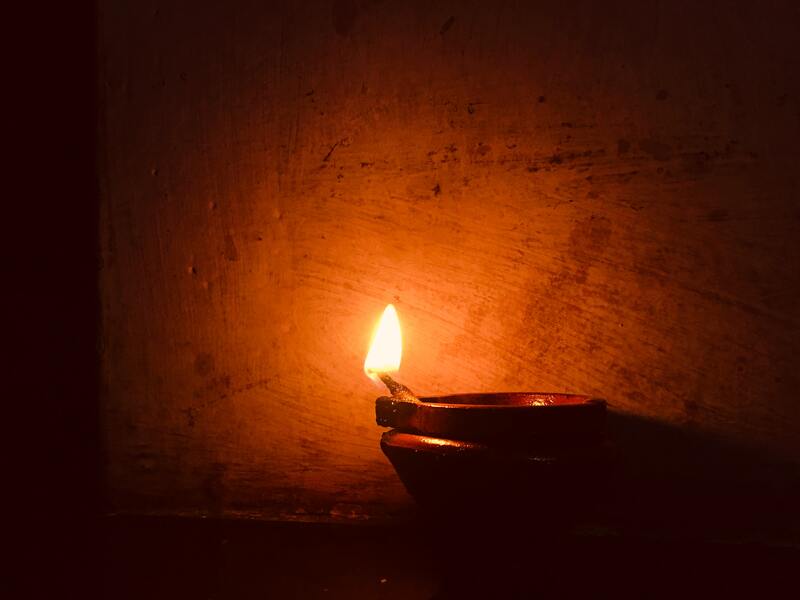Author: Randeep Singh / go to all Samkhya Karikas

Samkhya Karika 36 Text:
Ete pradip-kalpaa paraspar-vilakshana gunavisheshaah I
Kritsnam Purushas-yaartham prakashya buddhau prayacchati II
Ete – these
Pradip-Kalpaa – compared to a lamp
Paraspar-Vilakshana – inherently different
Gunavisheshaah – special modification of the
kritsnam – whole, complete
Purushas-ya – to Purusha
Artham – objects
Prakashya – illuminating, manifesting
Buddhau – to
Prayacchati – presents, offers
Samkhya Karika 36 enumerates the fact that all the 12 sense organs, apart from Buddhi which makes it the 13th sense organ, read their respective objects from their their own angles and present this collective information to Buddhi for its final exhibition to Purusha.
All Indriyas together are Like a Lamp, Buddhi is the Light
This Sankhya karika uses the analogy of an oil lamp to clarify the difference between the functions of Buddhi and the rest of the 12 indriyas, or sense organs.
A Lamp is made up of several parts. There is the oil, a cotton wick, body of terracotta or any of the rmaterial and so forth. All these parts of the oil lamp are structurally and functionally very different from each other. As they come together to form a lamp they all create a common function of generating light from the lit wick.
Similarly, all the 12 sense organs (indriyas) though very different in their functions finally unite to present their aspects (information) of the material objects to Buddhi in a unified manner, to create a unified experience to be reflected upon, or exhibited to Purusha.
Thus, Buddhi has its independent function of presenting this unified experience of material objects, collected through different sense organs, to Purusha, the conscious entity. In case Buddhi fails to perform optimally, correctly the Purusha will not receive the authentic experience of the material world.
This Sankhya Karika text clearly delineates the function and role of Buddhi as the most significant of all the other sense organs. Through Buddhi, Purusha witnesses all. This is why buddhi is considered as the principal (pradhan).
Buddhi is located nearest to Purusha (in the sequence of evolution of Prakriti). Only Buddhi has the discriminative power to analyze, All the other senses lack this ability.
Samkhya Karika 36, Buddhi is the Significant of All
Buddhi is very important in transformation of the personality of a human being. Buddhi exhibits 8 Bhavas, 4 positive and 4 negative, or qualities. One has to consciously inculcate the 4 positive bhavas for the discriminative knowledge to arise within it.
Or else, if the work for bringing in the positive bhavas is lacking the 4 negative bhavas will creep in which will keep the discriminative knowledge away from Buddhi, leading to its malfunction. Now Buddhi (intelligence) will not be able to create a valued experience from the collective information presented to it by all the sense organs.
For example, if the mind and other senses are let loose, without being guarded by Buddhi, under the influence of positive bhavas, their negative tendencies will lead them astray. It is only through intelligence that the mind and senses can be brought about towards understanding and progress.
Buddhi presents the collective experience collected via the sense organs to Purusha for a purpose. This purpose will be dealt in detail in later karikas. The experience so collected , in the form of information, by the sense organs have to meet certain standards of sagacity and purity (satvik) as it has to be present to Purusha for a reason or purpose.
If the control of Buddhi, filled with positive bhavas (tendencies) is lost over the mind it will start tracing the path of indulgent desires, which may be useless and harmful to creating valuable experience for Purusha, like smoking habit. It is only the Buddhi (intelligence) which can rationalize between good and bad, by using its discriminative power to keep the person away from smoking.
A businessman hid his money into a burglars jacket he happened to spend a night with. The burglar looked everywhere for the money but his own jacket at night. When enquired about in the morning the businessman said I was sure that you will not check your own jacket, so I hid it there.
This is the case with all ordinary humans. They fail to realize that the wealth (intelligence, Buddhi) that can change their entire being is actually available within themselves only, but they never make an effort to utilize it for their progress.
Intelligence or Buddhi is the only power which can steer our lives away from pain and ignorance.
Ashtanga yoga is the instruments which can help one realize this power and also fine tune it for one’s spiritual progress; realizing of the self or Purusha. Sadly enough, we want to use the potential of Buddhi to make more wealth and amass elements of pleasure for comfortable living.
From this karika onwards begins the understanding of evolutionary theory of intellectual evolution. The most vital event that occurs for any human being is the development of Buddhi, intellect. The faculties of mind are available to all beings in general, it is only the humans to whom Buddhi is available which can be expanded limitlessly.
The potential is present, we may or may not use or expand it further. It all depends on what we decide to do with it.
